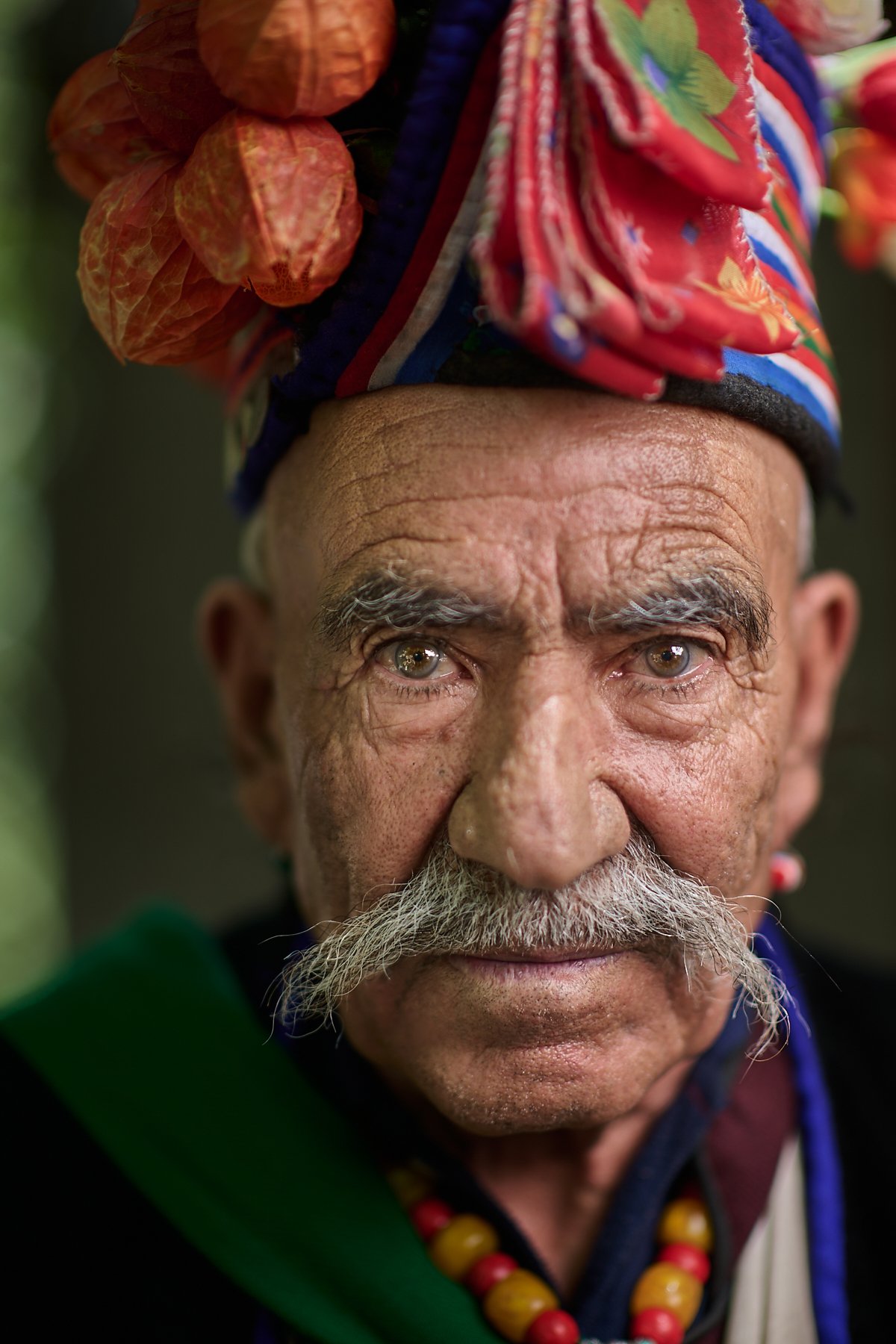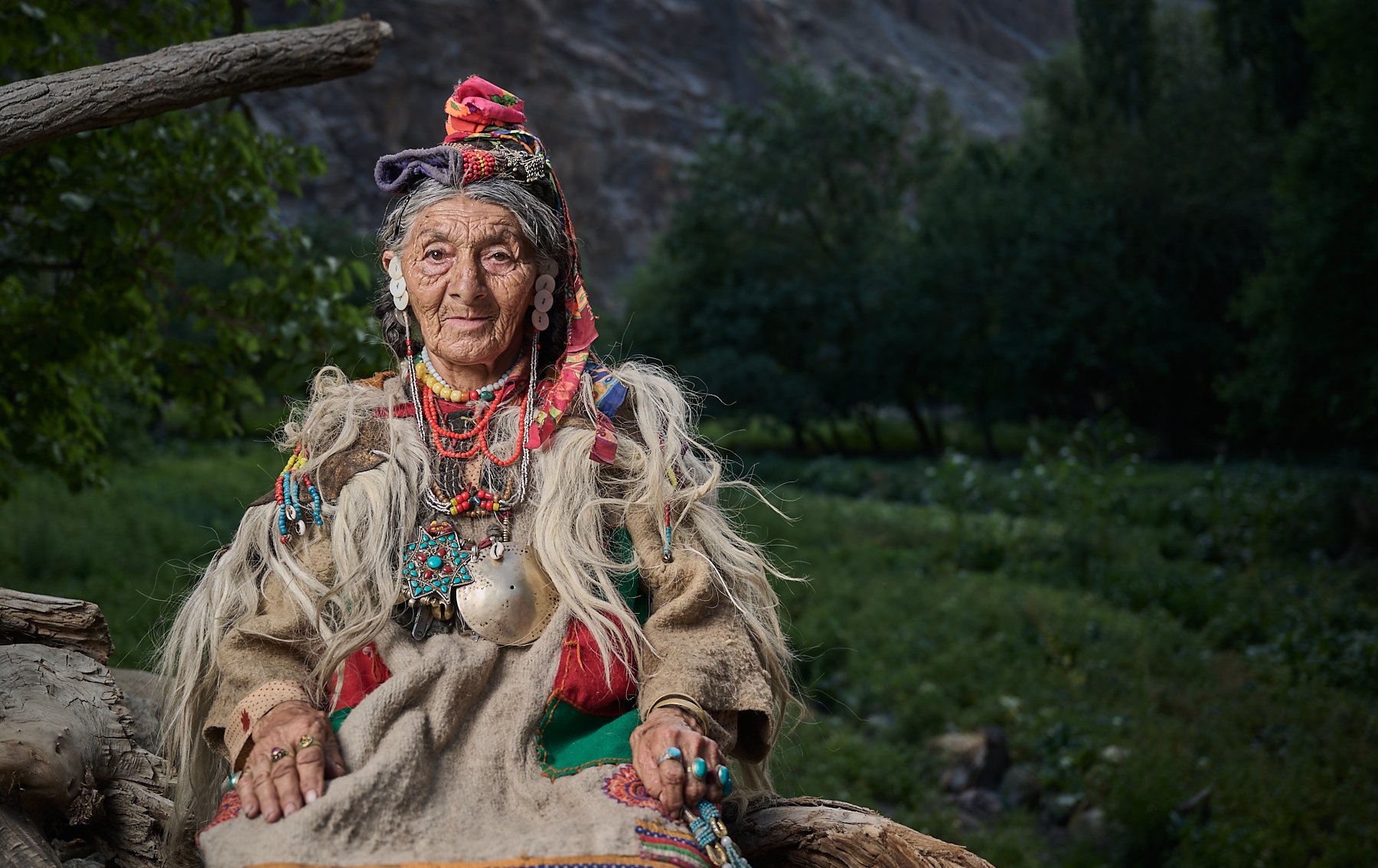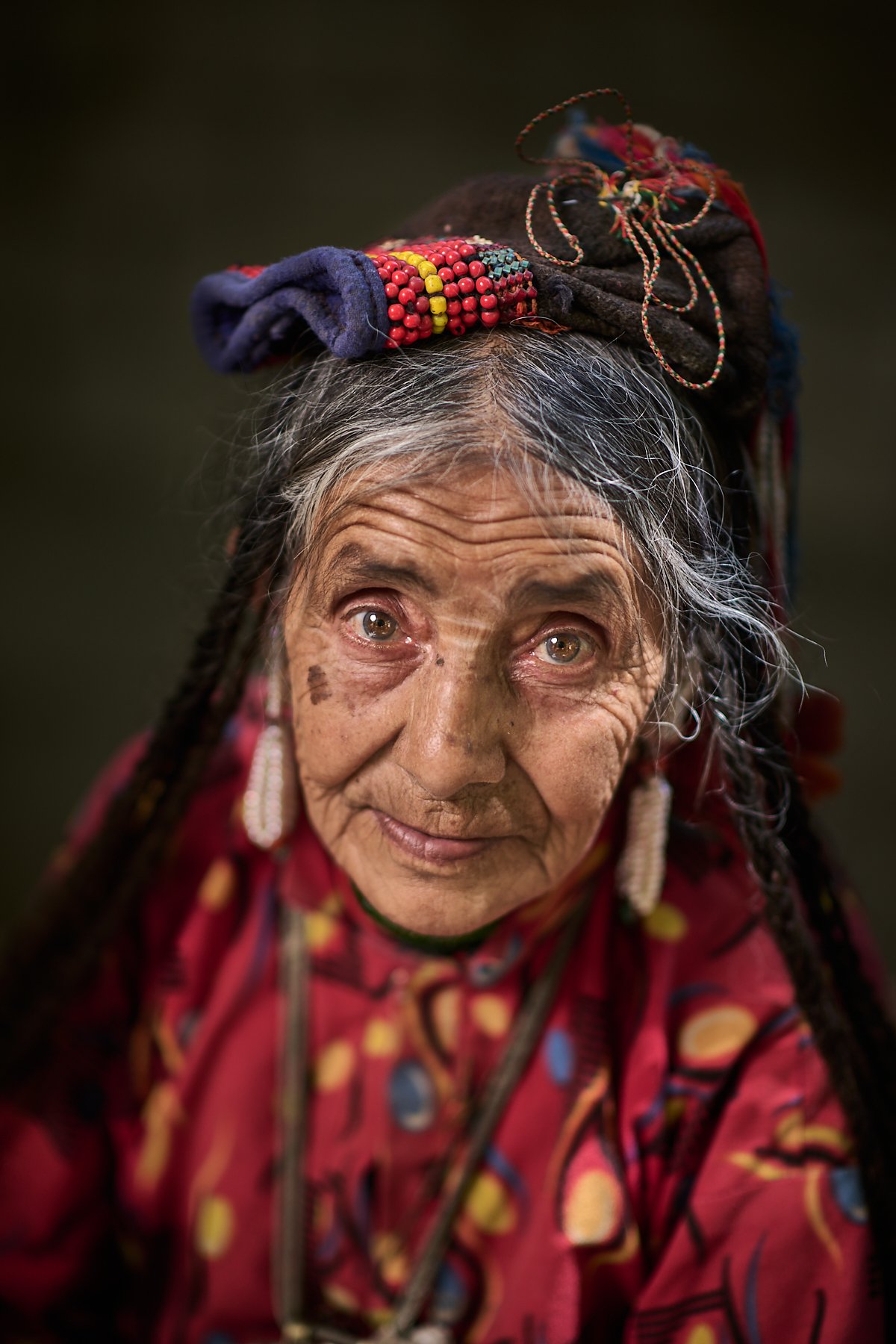The Aryans of Ladakh
They are know by different names depending on who you ask: the Aryan people or the Brokpa (plus a couple more beside that in different dialects) and, depending who you ask, their origins go back 2500 years or more or less. I must have read more than a a dozen different articles, diatribes and references and while I’m still no wiser than i was before, one thing is for sure: the moment you cross the “border” and head into the Aryan valley in northern Ladakh, you are no longer in India. Regardless of what international political borders say and regardless of what the Indian government may believe.
Tsering yangzom (left, 39) and Padma lhamo (right, 38) in the traditional harvest celebration attire sitting in front of the village’s hay drying area.
Now, this may not sound that much different than Nagaland - and in concept it may be - but in reality, things are different. While the people of Nagaland really do not like to be called Indian and clearly differentiate themselves from the rest of India, the Aryans, despite their significant differences from anything sub-continent related, they consider themselves to be Indian and proud to be so. There’s something there, I’m sure, but I have not been able to put my finger on it.
But, this is not a story about India’s diversity - it’s a story about the Aryans and it all starts with the landscape. The valley is an incredibly harsh but also very beautiful place - extremely narrow, in some places less than 100m at the bottom (and not much more at the top!), with the mighty Hindus roaring like a grey-brown furious serpent through the middle, framed by sharp granite, sandstone and basalt rocks rising so fast they almost seem vertical.
Gang Sonam (70) wearing his Sunday best - less ornate but also incredibly beautiful
Amidst the narrow crags, you will see flowers and trees growing out of almost impossible nooks and crannies, with any patch bigger than a bathtub overflowing with some crop or small apricot trees. And, of course, the tiny villages of the Aryans. Climbing like mountain goats along the sharp incline of the cliffs, sometimes with no more than a single house per level, these villages, with their narrow paths and the fresh mountain water flowing along each one, with their massive trees providing shade and the hundreds of apricot trees filling the air with their sweet smell and central cobblestoned village squares, they are more reminiscent of villages in the Balkans than India.
It is here that, from the moment you walk in, you come across the people, whether they are washing clothes in the freshwater or tending to their vegetable patches or, even more, gathered around the central square, laughing and gossiping, exchanging stories and, of course, checking out you, the new visitor. The people are fair skinned - and it takes you a few minutes to actually pick up on this, even if you were actually expecting it - have bright blue and green eyes and would look more at home in Europe than they do here.
Their behaviour, mannerisms and even customs simply do not match anything around them - not the Buddhist temples and monasteries or the Indian army bases or even Leh and the other major cities across Ladakh with their predominantly - these days - Indian population, organisation and customs.
They are decidedly a world of their own. The villages are clean - almost meticulously so and are covered with the byproducts of apricot cultivation - fresh and dried fruit, pulp for anything from jams to beer and brandy (both of them delicious!) - as well as extremely neat and tidy bales of wheat and barley, perfectly organised vegetable patches and long lines of freshly washed laundry. They are beautiful, harmonious with the nature around them and reminiscent of a Europe from more than 80 or even 100 years ago when life revolved around the small rural village.
Why have I gone on and on about their villages? Because you need to get the whole picture - because you cannot picture or understand the Aryans outside their environment and their villages - they become isolated figures with traditional clothes who could come from anywhere - you see one of the many “face against a sea of black” portraits of the Aryans and unless someone specifically says what they are, the casual observer can easily confuse them with Romanians or Armenians or even Greeks (and they very frequently do).
Tsering gyalzom (84), with the full celebratory attire, complete with 100yr old jewellery. Her headpiece, while not as ornate as others, it does some from her great-great-grandmother at a time when flowers were only added fresh (as opposed to these days where most decorative flowers are plastic or cloth)
Legend - and it is sort of supported by the visual evidence - says that the Aryans are the descendants of the soldiers of Alexander the Great who chose to stay behind following the multi year disastrous campaign over the Hindu Kush. The many soldiers who chose to remain built cities and settled down, frequently carrying with them the families they had created through their long march across Asia. Initially they populated a huge swath of the area around Ladakh but over the centuries and the huge political upheaval this particular region of the world has experienced - let us not forget that the Aryan valley is literally on the border between Ladakh and Kashmir - they have slowly been compressed into this narrow valley and the dozen or so villages.
Legend also - as legends tend to - claim that among the Aryan people rest the remaining vestiges of true/pure aryan race DNA (I’m not a scientist, but personally I really cannot see how that would be even remotely possible - anyway) which in the late 1970s and very early 80s led a group of Nazi sympathisers to travel to Ladakh with the express purpose of “extracting” that pure DNA. Apparently this caused enormous upheaval, both domestically are well as internationally, and the Indian government closed off access to the valley for almost a decade. I cannot vouch for the truth in this, but I did hear the same story from two of our local fixers and two village elders, so there must be some grain of truth in it.
This beautiful woman did not share her name or story with us, but she was happy to be photographed. She was sitting in the village square, dressed exactly like this, on a Wednesday afternoon.
But the Aryan people themselves are extremely nice - happy to talk to you, invite you to their home, share their daily lives with you. They are not really driven by some desire to spread their culture or make people aware like a lot of other minorities - it’s just they are proud and hospitable people. It is as simple as that. However, and this is a small word of caution, do not take liberties just because they are nice - do not assume their homes are automatically open to you, that their hay bales are yours to do whatever you want with them, that you can step on their spread dried apricots. Be respectful and cautious and all will be well.
I travelled through 5 different villages and I saw different things in each one - one was larger but at the same time more communal, its people closer together. Another was smaller but more spread out, it’s people less friendly overall. However, I felt perfectly at home in each one - with the aid of my fixer, I was able to photograph the Aryans in all their glory - and I use the term very specifically here. Dressed in both their every day clothes as well as their festival and wedding attires, either working or simply sitting around chatting, they were happy to be photographed and seeing the images at the back of the camera was the cause of many a laughter and teasing.
I wrote extensively about how hard the trip to Ladakh was for me here, but despite that, I would absolutely urge anyone in the region to try and spend 3 days (because you need 3 days as an absolutely minimum!) in the Aryan valley and meet these extraordinary people. Not only about who they are, but also about their uniqueness - the fact they have survived there over millennia without genetically fading away (which, for such a small population, in most places in the world, would have been a foregone conclusion), that they have developed their own distinct culture despite efforts not only from the Indian government but also the Buddhists across Ladakh and are still here is nothing sort of amazing. And beautiful to behold.
I don’t know how long the Aryans can remain who they are - their numbers are dropping (not massively, but it is happening) and slowly their language is going, replaced by Indian through the young people and television (there is very little internet in the valley - which may be a blessing in disguise). And while the young people still consider themselves proudly Aryan and love their culture, their festivals attract fewer and fewer people every year. I hope they resist this and they persist because the world wants - no, needs - these culturally different pockets across the world to survive and thrive. They are a testament to human resilience and one we should, as a species, be proud of.




